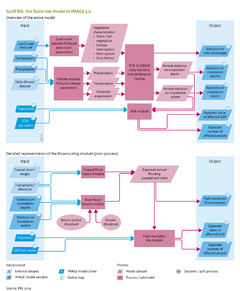Flood risks: Difference between revisions
Jump to navigation
Jump to search
ArnoBouwman (talk | contribs) No edit summary |
Oostenrijr (talk | contribs) m (Text replace - "km2" to "km<sup>2</sup>") |
||
| (41 intermediate revisions by 4 users not shown) | |||
| Line 1: | Line 1: | ||
{{ComponentTemplate2 | {{ComponentTemplate2 | ||
|IMAGEComponent=Drivers; Human development; Land cover and land use; | |||
|Model-Database=PCR-GLOBWB model; DIVA model; | |||
|KeyReference=Ward et al., 2013; Winsemius et al., 2012; | |||
|Reference=UNISDR, 2011; | |||
IPCC, 2012; | |||
Bouwer et al., 2010; | |||
Barredo et al., 2012; | |||
UNISDR, 2005; | |||
Bierkens and Van Beek, 2009; | |||
Hinkel and Klein, 2009; | |||
|InputVar=Land cover, land use - grid; Population - grid; GDP per capita - grid; Land cover, land use - grid; Temperature - grid; Precipitation - grid; | |||
|Parameter=Coastal storm surges; Flood statistics - grid; Daily climate dataset - grid; Topography, elevation - grid | |||
|OutputVar=Expected nr of affected people - grid; Expected value of affected GDP - grid; Statistics on inundation depth - grid; Statistics of inundation extent - grid; Statistics on river discharge - grid; | |||
|Description=Flooding is the most frequent and costly natural hazard that regularly affects many countries ([[UNISDR, 2011]]; [[IPCC, 2012]]). In the last few decades, economic damage as a result of flooding has increased in most regions, primarily due to growth in population and wealth in flood-prone areas ([[Bouwer et al., 2010]]; [[UNISDR, 2011]]; [[Barredo et al., 2012]]). In relative terms, economic loss and mortality from flooding are highest in developing countries, but lack of reliable and complete data remains an important issue for damage estimates. | |||
To evaluate current flood risk and how the risks may change under future global change scenarios, rapid cost-effective assessments based on available global data are required. Such assessments are required, for instance, by international financing institutes to assess investment in risk reduction of natural disasters and by national institutes to monitor progress in risk reduction, such as under the Hyogo Framework for Action ([[UNISDR, 2005]]), by companies to justify insurance coverage and to assess risks to regional investments. | |||
GLObal Flood Risks with IMAGE Scenarios ([[GLOFRIS model|GLOFRIS]]) was developed for IMAGE 3.0 jointly by Deltares; PBL Netherlands Environmental Assessment Agency; Utrecht University; and the Institute for Environmental Studies, VU University Amsterdam. GLOFRIS estimates river and coastal flood risks by integrating the global hydrological model [[PCR-GLOBWB model|PCR-GLOBWB]] ([[Bierkens and Van Beek, 2009]]) and the global sea-level rise impacts model [[DIVA model|DIVA]] ([[Hinkel and Klein, 2009]]), using climate scenario data from complex climate models and downscaled socio-economic scenarios from IMAGE. | |||
GLOFRIS is used to assess current and future flood risks related to climate, changing land-cover patterns and changing socio-economic conditions in all world regions. This can be done globally at a resolution of 0.5x0.5 degrees and regionally at a higher resolution (1x1 km<sup>2</sup>). The higher resolution is achieved using a specially developed downscaling algorithm and more detailed regional impact models. Impacts for various safety levels can be analysed. Possible applications include the preparation of IPCC scenarios for flood risk changes at 0.5 degree and 1 km<sup>2</sup> resolutions. | |||
|ComponentCode=FR | |ComponentCode=FR | ||
| | |AggregatedComponent=Impacts | ||
|FrameworkElementType=impact component | |FrameworkElementType=impact component | ||
}} | }} | ||
Revision as of 10:40, 1 July 2014
| Component is implemented in: |
|
| Related IMAGE components |
| Models/Databases |
| Key publications |
| References |
Key policy issues
- How will future flood risk change as a result of socio-economic changes and climate change?
- What would be the impact of floods, in terms of damage and victims, and where are the hot spots?
- What would be suitable adaptation strategies and investment options related to flood risk?
